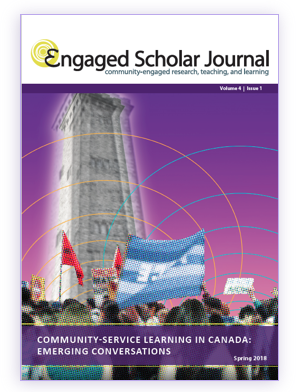A Study of Limits, Ignorance, and Reading Practices: Community Service-Learning as an Exercise in the Vision of Queer Pedagogy
DOI:
https://doi.org/10.15402/esj.v4i1.311Keywords:
community service-learning, queer pedagogy, queer theory, archivingAbstract
Theories and practices of community service-learning (CSL) have implicated it in a broad project of confronting the unthinkability of privilege and difference, the culturally situated, political nature of knowledge, and the dialogical, transformative potential of reading. I argue that this understanding of CSL largely aligns in vision, directives, and prospects with an exercise in queer pedagogy. With its critical inquiry into pedagogical practice informed by queer theory, Deborah Britzman’s triangulated queer pedagogy not only shares productive theoretical ground with CSL, but can also be seen to inform, enhance, and develop the academic role of service-learning as a methodology of teaching and learning. Through its development in academic institutions in Canada, CSL should look to queer theory’s established lexicon in order to take up precise, thickly descriptive, exoteric language which reflects the two fields’ productive commonalities. Furthermore, where CSL literature often identifies as volunteerism, internship, and experiential learning, queer pedagogy ascribes deep transformative potential to its approach—a perspective and a potential often undervalued by practitioners of CSL. Finally, a bringing together of community service-learning and queer pedagogy illustrates the need in service-learning literature for an approach to systematic archiving which more closely adheres to the field’s emphasis on the creation of deeply reflective and creative academic work.
Downloads
Published
How to Cite
Issue
Section
License
Authors who publish with this journal agree to the following terms:
- Authors retain copyright and grant the journal right of first publication with the work simultaneously licensed under a Creative Commons Attribution License CC BY 4.0 that allows others to share the work with an acknowledgement of the work's authorship and initial publication in this journal.
- Authors are able to enter separate, additional contractual agreements for the non-exclusive distribution of the journal's published version of the work (e.g., post it to an institutional repository or publish it in a book), with an acknowledgement of its initial publication in this journal.
- Authors are permitted to post their work online (e.g., in an institutional repository or on their website) after the publication of their work in the Engaged Scholar Journal.
- Please note that while every opportunity will be taken to ensure author participation in the editing process, due to time constraints final copyediting changes may be made before publication to ensure APA adherence throughout all submissions.




